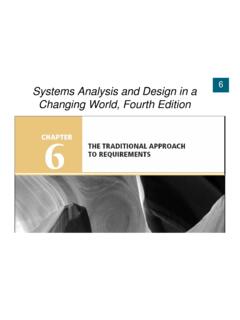Transcription of PROJECT REPORT OF BUILDING COURSE MANAGEMENT …
1 PROJECT REPORT OF BUILDINGCOURSE MANAGEMENT SYSTEMBY DJANGO FRAMEWORKbyYiran Zhoua REPORT submitted in partial fulfillmentof the requirements for the SFU-ZU dual degree ofBachelor of Sciencein the School of Computing ScienceSimon Fraser Universityandthe College of Computer Science and TechnologyZhejiang Universityc Yiran Zhou 2010 SIMON FRASER UNIVERSITY AND ZHEJIANG UNIVERSITYS pring 2010 All rights reserved. This work may not bereproduced in whole or in part, by photocopyor other means, without the permission of the :Yiran ZhouDegree:Bachelor of ScienceTitle of REPORT : PROJECT REPORT OF BUILDING COURSE MANAGE-MENT system BY DJANGO FRAMEWORKE xamining Committee:Dr.
2 Qianping Gu, SupervisorDr. Ramesh Krishnamurti, ExaminerDate Approved:iiAbstractThis REPORT introduces the process of creating part of a COURSE MANAGEMENT system whichis a data-driven website used by the instructors and students. This website has four ma-jor components: grade, marking, group, and submission. The major part of the groupcomponent and minor part of marking component are implemented by me and the imple-mentation details will be introduced in the REPORT . The implementation uses a tool calledDjango Framework which is an excellent open source web application frame work for com-plex data-driven website development.
3 The major part of this REPORT will introduce how touse Django to create a database table, web page user interface and inner logic to handleuser request by going through the group component implementation Background .. Significance .. Method used .. Limitation .. REPORT Organization ..22 Django framework .. Python ..53 PROJECT An overview of the PROJECT .. An overview of the Django framework development process ..74 Create the database tables95 Create the User Interface126 Implement the view function16iv7 Functionalities implemented in group An overall view of group component.
4 Functionalities in the PROJECT scope .. Functions out of PROJECT scope .. 228 Conclusion23vChapter 1 IntroductionThis PROJECT REPORT will introduce how to build part of a COURSE MANAGEMENT system usingthe Django framework[1]. Django is an open source web application frame work which iswritten in Python[2]. This COURSE MANAGEMENT system built using Django has four majorcomponents each of which has different functionality but similar architecture. In the projectreport I will demonstrate details of using Django to build one major component of thissystem: the group component, which is my major contribution to the whole system .
5 Alsothe technique and process which is showed here can be applied to build the other threecomponents in the COURSE MANAGEMENT system as well as other complex BackgroundSFU has several disparate systems for COURSE MANAGEMENT . They are: grade book, which isused to allow students to see their grades in every activity in their COURSE ; online markingsystem, which is used by teaching assistants and instructors to calculate the grade of theirstudents; submission web service, which is by students to submit their assignments. Thesethree systems are logically related but in reality they are implemented as individual systemsand located on different servers.
6 So the technical maintenance team needs to spend a lot oftime and energy to support these three different systems. Also these systems were built along time ago and it is hard for the technical team to maintain and add new functionalitieswhich are required as time goes by. So the purpose of this PROJECT is to create a newintegrated scalable COURSE MANAGEMENT system with all the existing functionalities in these1 CHAPTER 1. INTRODUCTION2three systems, as well as new functionalities if SignificanceThe new COURSE MANAGEMENT system will integrate all existing functionalities of the threesystems as well as other new functions.
7 Thus the technical team only needs to maintainone system instead of three. The scalability of the new system will allow them to add morefeatures to the system in future. Students and professors only need to log into one systemto accomplish what they did on the three systems before. This will be more convenient andsignificantly improve their Method usedThis system is built using Django web application framework. Django was originally devel-oped for the news-oriented site of the world company in Lawrence, Kansas[3]. It simplifiesthe development process of complex, data-base driven web applications like a news-orientedsite.
8 Its well-designed framework includes three major parts: model, view and template[4].Our COURSE MANAGEMENT system consists of four components which are grades, marking,group and submission. Each component contains those three parts. When we develop thecourse MANAGEMENT system , we first design the model of the relative component for dataarchitecture, then the template for user interface, at last we implement the view whichincludes all the LimitationComplex websites such as the COURSE MANAGEMENT system usually take some time to test andvalidate. The system may have some potential bugs or flaws because of the developmenttime constraint.
9 However because of the flexibility and powerful functionality of Django,these bugs or flaws can be REPORT OrganizationIn next Chapter, which is Chapter 2, we give the preliminaries of the REPORT . Chapter 3 isan overview of the whole PROJECT . From Chapter 4 to Chapter 6, we will give the details ofCHAPTER 1. INTRODUCTION3each component in Django to implement one process in the group component of the system ,namely creating a new group for some group activities. Chapter 4 describes how to deal withthe database to create database tables for groups. The user interface for input informationfor a new group is discussed in Chapter 5.
10 Chapter 6 introduces the view function forprocessing the create group request. Chapter 7 contains all the functionalities that I Django frameworkDjango is an open source web application frame work written in Python. The primary goalof Django is to make the development of complex, data-based websites easier. Thus Djangoemphasizes the reusability and pluggability of components to ensure rapid consists of three major parts: model, view and template[4]. ModelModel[4] is a single, definitive data source which contains the essential field and behaviorof the data. Usually one model is one table in the database.



